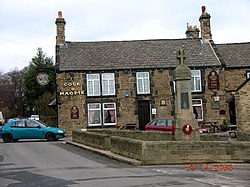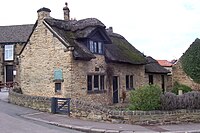Old Whittington
| Old Whittington | |
| Derbyshire | |
|---|---|
 The Cock and Magpie Inn, Old Whittington | |
| Location | |
| Grid reference: | SK383748 |
| Location: | 53°16’10"N, 1°25’35"W |
| Data | |
| Population: | 4,181 (2011) |
| Post town: | Chesterfield |
| Postcode: | S41 |
| Dialling code: | 01246 |
| Local Government | |
| Council: | Chesterfield |
| Parliamentary constituency: |
Chesterfield |
Old Whittington is a village in Derbyshire two miles north of Chesterfield, of which it has become a suburb. It is some ten miles south-east of Sheffield. The population of the ward at the 2011 Census was 4,181.
The village is on the bank of the River Rother.
Industries of the village in the industrial age were the manufacture of stoneware bottles, other earthenware and bricks. There were also coal mines and ironworks.
The parish church is St Bartholomew. It was restored after its destruction by fire, except for the tower and spire, in 1895.
Early history
Old Whittington is mentioned in the Domesday Book on the first folio for Derbyshire where it is then spelt Witintune. The book says under the title of 'The lands of the King':
In Newbold with six berewicks—Old Whittington, Brimington, Tapton, Chesterfield, Boythorpe, Eckington—there are six carucates and one bovate to the geld. There is land for six ploughs. There the king has 16 villeins and one slave having four ploughs. To this manor belong eight acres of meadow. There is woodland pasture three leagues long and three leagues broad. In the time of King Edward worth £6 now £10.

St Bartholomew Church
The grade II listed St Bartholomew's Church was built in 1869. This is the fourth church to occupy the site, the first being the Norman church built circa 1140 AD.
About the village
The school

A free school was founded here in 1674 which was endowed with lands which created an income of thirty two pounds and ten shillings. The school had about twenty pupils which included both boys and girls. Old Whittington now has 3 schools, the primary school is called Mary Swanwick, the special school is called Holly House and the secondary school is called Whittington Green School.[1]
Revolution House

- Main article: Revolution House
Revolution House is a small stone cottage, which is now a museum.[2] This was the meeting-place in 1688 of the Earl of Danby, Mr. John D'Arcy (fourth son of the Earl of Holderness) and the Earl of Devonshire when poor weather caused them to move their secret meeting inside the inn, the "Cock and Pynot". William Cavendish, the fourth Earl and later Duke of Devonshire, whose tutor from childhood had been Thomas Hobbes, lived nearby at Chatsworth House, which is still the home to the Cavendish family.
This group devised the plans to extend the invitation to William of Orange to overthrow the tyranny and popery of King James II and ensure a whiggish, Protestant succession. This change was known as the Glorious Revolution, hence the name of Revolution House.
The local vicar, Samuel Pegge, was amongst about fifty dignitaries who met at Revolution House in 1788 on the centennial of the Glorious Revolution, while it was still an alehouse. The procession was led by the Duke of Devonshire, the Duchess and the Mayor of Chesterfield.[3]
The tiny museum today features period furnishings and exhibition of local interest.[4]
The Cock and Magpie
There is a public house in Old Whittington which is called the Cock and Magpie, founded in 1790 when the old 'Cock and Pynot' (now Revolution House) was converted into a cottage. The name of the pub of today is taken from that of the old inn: 'pynot' is a local word for a magpie.
Outside links
| ("Wikimedia Commons" has material about Old Whittington) |
References
- ↑ Genuki accessed 26 August 2007
- ↑ Revolution House at Culture24.org.uk accessed 22 November 2009
- ↑ Revolution House at PeakDistrictOnLine.co.uk accessed 26 August 2007
- ↑ Whittington at Derbyshireuk.net
